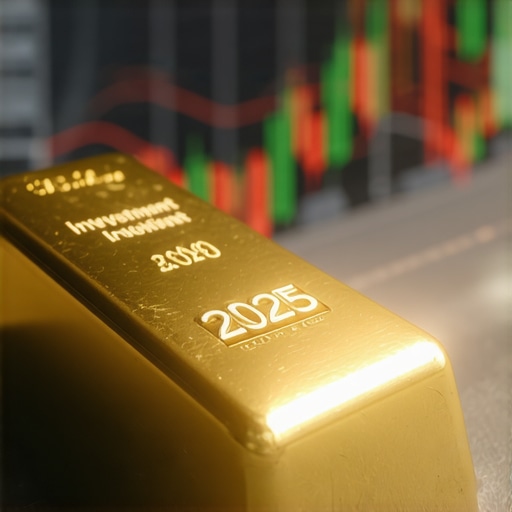Strategic Integration of Gold in Diversified Portfolios: Beyond Traditional Hedging
In the evolving landscape of investment assets, gold remains an indispensable element for portfolio diversification and risk mitigation. However, the simplistic view of gold as merely a hedge against inflation or currency depreciation understates its nuanced role in amplifying portfolio returns when deployed through advanced strategies. This article delves into sophisticated gold investment techniques that transcend conventional wisdom, leveraging market dynamics, asset class correlations, and structural demand drivers to optimize returns in 2025 and beyond.
Leveraging Gold ETFs and Mutual Funds for Tactical Exposure
Exchange-traded funds (ETFs) and mutual funds focused on gold offer investors liquid, cost-efficient access to gold’s performance without the complexities of physical storage. Expert investors exploit sector-specific gold ETFs and mutual funds to tactically adjust portfolio exposure in response to macroeconomic signals. For instance, dynamically rebalancing allocations between gold mining ETFs and physical gold-backed funds can capitalize on mining sector operational leverage while maintaining the safety net of bullion-backed assets. Such nuanced ETF strategies require continuous market analysis and understanding of fund structures, expense ratios, and liquidity profiles. Readers interested in a detailed breakdown can explore gold ETFs and mutual funds top picks for diversification for expert-curated options.
Exploiting Physical Gold Investment Nuances: Bars vs. Coins
Physical gold investments remain popular for their tangible asset security, but choosing between bars and coins involves a complex calculus beyond face value. Bars offer lower premiums but require verification of authenticity and secure storage solutions, while coins provide liquidity advantages and numismatic value but often carry higher premiums. Experienced investors incorporate a hybrid approach, balancing acquisition costs, resale market liquidity, and long-term capital appreciation potential. Comprehensive guides such as choosing between gold bars and coins for physical investing provide critical insights into optimizing physical gold holdings.
How Do Central Bank Gold Purchases Influence Market Volatility and Investment Timing?
Central banks have become pivotal players in the gold market, with their strategic gold acquisitions and sales significantly impacting price dynamics. Understanding the timing, scale, and geopolitical motivations behind these purchases enables investors to anticipate price volatility and adjust their portfolios accordingly. Central bank buying often signals shifts in monetary policy confidence, currency stability concerns, or diversification of reserves away from fiat currencies, all of which can precipitate sharp gold price movements. Detailed market analysis, such as that found in analyzing central bank gold purchases and market effects, is essential for investors aiming to harness these macro influences.
Incorporating Gold Mining Stocks with Risk-Adjusted Return Optimization
Gold mining equities offer leveraged exposure to gold prices but introduce operational and geopolitical risks unique to mining companies. Advanced strategies incorporate fundamental analysis of mining costs, geopolitical risk assessments, and technological innovation impacts to build a portfolio of mining stocks that balance growth potential with downside protection. Investors often complement physical gold and ETFs with carefully selected mining stocks to achieve asymmetric return profiles. For an expert roadmap, consider best gold stocks to watch for high returns in 2025.
Call to Action: Enhance Your Expertise with Advanced Gold Market Analysis
To deepen your mastery of gold investment strategies and stay ahead in the complex 2025 market environment, explore our comprehensive resources on mastering gold market analysis. Engage with expert discussions and contribute your insights to shape a robust investment community.
Authoritative source: World Gold Council’s 2024 report on gold demand dynamics provides an empirical foundation for strategic gold investment decisions (World Gold Council – Gold Demand Trends).
Integrating Gold Volatility Patterns into Tactical Asset Allocation
Gold’s unique volatility profile distinguishes it from traditional asset classes, offering both challenges and opportunities for sophisticated portfolio managers. Unlike equities, gold can experience sharp price swings prompted by geopolitical tensions, currency fluctuations, and unexpected macroeconomic shifts. Expert investors incorporate quantitative models that analyze gold’s volatility clustering and mean-reversion tendencies to time entry and exit points more precisely. By overlaying these models with broader market indicators such as the VIX or bond yield movements, one can enhance tactical allocation decisions within multi-asset portfolios. For deeper insights on navigating these patterns, see our guide on smart gold trading techniques to navigate volatile 2025 markets.
Gold’s Role Amidst Global Economic Shifts: Emerging Market Demand and Supply Dynamics
Emerging markets continue to reshape global gold demand, particularly through increased jewelry consumption and central bank reserve diversification. Countries like India and China exert outsized influence on gold price trajectories, as cultural affinity and economic growth drive sustained demand. Conversely, supply-side dynamics, including mining output constraints and refining capacity bottlenecks, add complexity to price forecasting. Investors must monitor these international demand-supply variables alongside geopolitical developments, such as trade tensions or regulatory reforms affecting mining jurisdictions. Comprehensive analyses of these factors support more informed decision-making, as detailed in analyzing global gold demand trends to predict price movements.
How Can Investors Leverage Algorithmic Trading to Optimize Gold Investment Returns in 2025?
The rise of algorithmic trading introduces a transformative edge for gold investors aiming to capitalize on intraday price movements and volatility. By deploying machine learning algorithms that parse vast datasets—including macroeconomic releases, social sentiment, and order book depth—investors can execute trades with precision and reduced emotional bias. These systems adapt to evolving market conditions, identifying optimal buy and sell thresholds while managing risk exposure dynamically. However, successful implementation demands rigorous backtesting, robust data infrastructure, and continuous strategy refinement. For those interested in harnessing algorithmic approaches, effective gold trading techniques to maximize 2025 profits offers a comprehensive blueprint.
Impact of Inflation-Linked Instruments on Gold Investment Strategies
Inflation-linked financial instruments, such as Treasury Inflation-Protected Securities (TIPS), provide investors with alternatives to gold for inflation hedging. Yet, gold’s non-yielding nature and intrinsic store of value continue to differentiate it within diversified inflation protection frameworks. Savvy investors blend gold with inflation-linked bonds to balance liquidity, yield, and real asset exposure. This hybrid approach mitigates the potential underperformance of any single inflation hedge during complex economic cycles. Integrating gold alongside inflation-indexed assets requires nuanced portfolio calibration, leveraging correlations that evolve with monetary policy shifts and market sentiment.
Enhanced Due Diligence: Evaluating Gold Dealer Credibility in a Fragmented Market
As the physical gold market grows increasingly fragmented, rigorous vetting of gold dealers becomes paramount to safeguard investments. Beyond price and premiums, investors must assess dealer reputation, authentication protocols, and delivery logistics. Utilizing third-party verification services and understanding industry certifications can minimize fraud risks. Additionally, leveraging digital tools for provenance tracking enhances transparency and investor confidence. For practical steps on securing trustworthy physical gold acquisitions, refer to choosing trusted gold dealers.
Technology and Gold: Blockchain’s Emerging Role in Physical Gold Transactions
Blockchain technology is revolutionizing the gold investment landscape by providing immutable records of ownership and provenance. Tokenization of physical gold assets facilitates fractional ownership, enhances liquidity, and reduces counterparty risks. Investors can now participate in gold markets with greater transparency and efficiency, particularly in jurisdictions where physical transfer and storage present logistical challenges. While regulatory frameworks continue to evolve, early adopters gain access to innovative investment structures that blend traditional gold’s stability with digital asset flexibility.
Authoritative source: According to the 2024 World Gold Council report, technological innovations and emerging market demand are key drivers reshaping gold’s investment landscape globally (World Gold Council – Gold Demand Trends).
Call to Action: Engage with Cutting-Edge Gold Investment Strategies
We invite readers to share their experiences or questions regarding advanced gold investment techniques in the comments below. To further refine your approach, explore our in-depth articles on advanced gold trading techniques and elevate your portfolio’s performance in 2025.
Decoding Gold’s Intraday Volatility: Quantitative Models for Precision Timing
Gold’s intraday price volatility presents both an opportunity and a risk for portfolio managers with a sophisticated understanding of market microstructure. Unlike broader asset classes that tend to follow more predictable cycles, gold’s price can be jolted by sudden geopolitical events or unexpected economic releases, creating sharp but transient price swings. Advanced investors employ high-frequency data analytics and volatility clustering models—such as GARCH (Generalized Autoregressive Conditional Heteroskedasticity)—to capture and predict these bursts in volatility. These models facilitate the identification of mean-reversion tendencies following volatility spikes, enabling tactical entry and exit strategies that improve risk-adjusted returns.
Integrating signals from global macroeconomic indicators alongside intraday gold volatility patterns enhances the robustness of these models. For example, coupling bond yield curve steepness with gold’s volatility surface can refine timing for tactical rebalancing within diversified portfolios, especially when inflation expectations are in flux.
What Are the Challenges and Opportunities in Implementing Algorithmic Gold Trading Strategies in Emerging Markets?
While algorithmic trading offers a cutting-edge advantage, deploying these strategies in emerging markets introduces unique complexities. Market microstructure inefficiencies, lower liquidity, and regulatory constraints can lead to slippage and execution risk. However, the growing digitization of trading venues and improvements in data transparency have begun to mitigate these issues.
Opportunities lie in exploiting informational asymmetries and integrating alternative data streams—such as satellite imagery of mining activity or sentiment analysis from local news sources—to anticipate supply shocks and demand surges. Algorithmic models that incorporate these unconventional datasets can provide early signals not yet priced into the market, offering alpha generation avenues for savvy investors.
Blockchain Tokenization: Transforming Gold’s Liquidity and Ownership Paradigm
Blockchain-enabled tokenization is reshaping the traditional gold investment framework by fractionalizing ownership and enhancing liquidity without compromising asset security. Through smart contracts, investors gain access to gold-backed tokens that represent verifiable claims on physical gold stored in insured vaults worldwide. This innovation reduces barriers to entry, especially for smaller investors, by lowering minimum investment thresholds and enabling seamless peer-to-peer transfers.
Moreover, blockchain’s immutable ledger provides unparalleled provenance tracking, mitigating fraud and counterparty risk. This transparency is particularly valuable in markets where physical gold authentication has historically been challenging. Regulatory clarity around tokenized assets remains in development, but jurisdictions pioneering these frameworks are poised to become hubs for gold-backed digital asset trading.

Assessing the Impact of Inflation-Linked Derivatives on Gold’s Portfolio Utility
Inflation-linked derivatives, including inflation swaps and options on TIPS, have become more accessible to institutional investors seeking nuanced inflation hedging. These instruments offer customizable exposure profiles but introduce counterparty and liquidity risks absent in physical gold holdings. Integrating gold with a basket of inflation-linked derivatives requires advanced portfolio optimization techniques that account for evolving correlation structures under different monetary policy regimes.
Dynamic hedging strategies employ scenario analysis and stress testing to evaluate portfolio resilience against stagflationary shocks or deflationary spirals. Gold’s historically negative correlation with certain asset classes during inflationary spikes can complement derivatives that perform better under moderate inflation, thereby smoothing portfolio volatility.
Advanced Due Diligence Frameworks: Navigating the Fragmented Physical Gold Dealer Market
With the proliferation of gold dealers worldwide, investors must adopt a multi-dimensional due diligence framework to mitigate counterparty and authenticity risks effectively. This includes assessing dealers’ adherence to the London Bullion Market Association (LBMA) Responsible Gold Guidance, evaluating third-party audit certifications, and scrutinizing supply chain transparency.
Technological tools such as RFID tagging and blockchain-enabled provenance databases further empower investors by enabling real-time verification of gold shipments and ownership history. Engaging with dealers who participate in responsible sourcing initiatives also aligns investments with Environmental, Social, and Governance (ESG) criteria increasingly demanded by institutional investors.
For comprehensive guidance, explore our resource on choosing trusted gold dealers, which details practical steps to safeguard your physical gold investments.
Refining Portfolio Strategies Through Gold’s Volatility Clustering and Regime Shifts
Incorporating regime-switching models that detect shifts between low and high volatility states enhances the precision of gold asset allocation. By leveraging Markov regime-switching frameworks, investors can anticipate dynamic changes in gold’s risk profile and adapt exposure accordingly. This approach complements traditional GARCH models by capturing abrupt transitions triggered by geopolitical upheavals or monetary policy surprises, thus optimizing tactical positioning within multi-asset portfolios.
Integrating ESG Considerations into Gold Supply Chain Analysis for Responsible Investing
Environmental, Social, and Governance (ESG) factors have become increasingly critical in evaluating gold mining operations. Advanced investors now incorporate ESG risk assessments into fundamental valuations, favoring mining companies demonstrating responsible sourcing, community engagement, and robust environmental stewardship. This integration not only aligns portfolios with emerging regulatory frameworks but also mitigates long-term operational risks that can adversely affect returns. Detailed ESG ratings from agencies such as Sustainalytics provide crucial data for constructing ethically optimized gold investment portfolios.
How Can Machine Learning Enhance Predictive Analytics for Gold Price Movements Amid Complex Macro Drivers?
Machine learning techniques, including ensemble methods and neural networks, enable the synthesis of heterogeneous data sources—ranging from macroeconomic indicators to sentiment metrics—to forecast gold price trajectories with improved accuracy. Feature engineering that captures nonlinear interactions among inflation rates, real interest rates, and geopolitical risk indices boosts model robustness. Continuous retraining on high-frequency data ensures adaptability to regime changes, offering investors a tactical edge in timing entries and exits. For practitioners, platforms such as TensorFlow and PyTorch facilitate the development of bespoke predictive models tailored to gold market idiosyncrasies.
Augmenting Liquidity and Transparency via Blockchain-Enabled Gold Tokenization Platforms
Tokenization platforms employing blockchain technology are progressively bridging the gap between physical gold and digital assets, fostering enhanced liquidity and investor accessibility. These platforms often incorporate multi-layered smart contract protocols to automate compliance, custody, and dividend distributions, thereby reducing operational overhead. Additionally, integration with decentralized finance (DeFi) ecosystems opens novel avenues for collateralization and yield generation against gold-backed tokens. Early adopters benefit from reduced counterparty risks and streamlined settlement processes, positioning tokenized gold as a frontier in asset digitization.
Advanced Risk Management Through Inflation-Linked Derivatives and Gold Correlation Dynamics
Cutting-edge portfolio management employs dynamic copula models to capture time-varying correlations between gold and inflation-linked derivatives, facilitating sophisticated hedging strategies. These models accommodate tail dependencies and asymmetries in joint return distributions, essential during turbulent economic regimes. By combining gold with inflation swaps and TIPS options, investors can construct resilient portfolios that adapt to stagflationary pressures or disinflation scenarios, balancing yield and capital preservation objectives.
Elevating Due Diligence with AI-Powered Authentication and Real-Time Market Surveillance
Artificial intelligence applications in gold dealer vetting now extend to image recognition algorithms for verifying physical gold authenticity, anomaly detection in transaction patterns, and predictive analytics for counterparty risk. Coupling these technologies with blockchain provenance data enhances transparency and fraud mitigation. Real-time market surveillance tools equipped with natural language processing analyze news feeds and regulatory filings to preemptively identify reputational or operational risks associated with gold suppliers, empowering investors with actionable intelligence.
Call to Action: Engage with the Frontier of Gold Investment Innovation
We encourage investors and industry professionals to delve into these advanced methodologies and technological innovations shaping gold investment in 2025. Share your perspectives or seek tailored advice through our specialized forums and expert webinars, designed to elevate your strategic decision-making and portfolio outcomes.
Authoritative source: For comprehensive insights into gold’s evolving investment landscape and the implications of technological integration, consult the World Gold Council’s 2024 research on gold demand and innovation (World Gold Council – Gold Demand Trends).
Expert Insights & Advanced Considerations
Gold’s Volatility Clustering Enhances Tactical Allocation Precision
Understanding gold’s volatility clustering and regime shifts allows investors to refine timing for portfolio entries and exits. By employing advanced models such as Markov regime-switching in conjunction with GARCH frameworks, portfolio managers can anticipate abrupt changes due to geopolitical or macroeconomic shocks and adapt allocations dynamically to optimize risk-adjusted returns. This nuanced approach outperforms static strategies and complements broader market indicators.
Algorithmic Trading in Gold Markets Requires Contextual Adaptation for Emerging Economies
While algorithmic trading offers significant opportunities in gold markets, especially leveraging alternative data sources like satellite mining activity and sentiment analytics, deploying these strategies in emerging markets demands tailored solutions. Market microstructure inefficiencies and regulatory variability necessitate rigorous backtesting and infrastructure robustness to mitigate execution risks and slippage, unlocking alpha through informational asymmetries.
Blockchain Tokenization is Redefining Liquidity and Provenance in Physical Gold Investments
Tokenization of physical gold via blockchain platforms is revolutionizing ownership paradigms by enabling fractional investments, enhancing liquidity, and securing immutable provenance records. These innovations reduce barriers to entry and fraud, especially in jurisdictions with logistical challenges for physical gold custody, while regulatory frameworks evolve to accommodate this digital transformation.
Integrating Inflation-Linked Derivatives Complements Gold’s Inflation Hedge Effectiveness
Combining gold holdings with inflation-linked derivatives such as TIPS options and inflation swaps facilitates sophisticated hedging strategies that accommodate diverse inflationary regimes. Dynamic copula models capturing time-varying correlations enable portfolio resilience against stagflation and deflation scenarios, balancing yield generation with capital preservation in volatile economic cycles.
ESG Factors are Crucial in Mining Stock Selection and Responsible Gold Investing
Incorporating Environmental, Social, and Governance criteria into gold mining stock analysis mitigates long-term operational risks and aligns investments with emerging regulations and investor preferences. Robust ESG assessments identify companies excelling in responsible sourcing and community engagement, enhancing portfolio sustainability and ethical alignment without sacrificing returns.
Curated Expert Resources
- World Gold Council – Gold Demand Trends (https://www.gold.org/goldhub/research/gold-demand-trends): The definitive report offering empirical data and deep analysis on global gold demand drivers and technological impacts.
- Mastering Gold Market Analysis (https://buyingoldnow.com/mastering-gold-market-analysis-insights-for-savvy-investors): A comprehensive resource for sophisticated investors seeking cutting-edge analytical techniques for gold price forecasting and strategic positioning.
- Advanced Gold Trading Techniques (https://buyingoldnow.com/advanced-gold-trading-techniques-to-maximize-your-gains): Detailed guides on algorithmic strategies, volatility models, and market timing methods tailored for maximizing 2025 returns.
- Choosing Trusted Gold Dealers (https://buyingoldnow.com/choosing-trusted-gold-dealers-tips-for-safe-physical-purchases): Practical steps and criteria for vetting dealers to ensure authenticity and security in physical gold acquisitions.
- Analyzing Global Gold Demand Trends (https://buyingoldnow.com/analyzing-global-gold-demand-trends-to-predict-price-movements): Insightful analysis of international demand-supply dynamics and their implications on gold price trajectories.
Final Expert Perspective
Gold’s multifaceted role in diversified portfolios continues to evolve amid rapid technological innovation and shifting global economic paradigms. The integration of volatility-driven quantitative models, algorithmic trading adapted for diverse markets, and blockchain-enabled tokenization collectively redefine how investors approach gold in 2025. Complementing physical and derivative exposures with ESG-conscious mining stock selection further elevates portfolio resilience and ethical stewardship. Mastery of these advanced gold investment strategies, supported by authoritative resources, empowers sophisticated investors to navigate uncertainty with precision and confidence.
For those committed to elevating their expertise and portfolio performance, engaging with these innovations and analytical frameworks is indispensable. Explore mastering gold market analysis and advanced gold trading techniques to deepen your strategic edge in the complex 2025 gold investment landscape.










